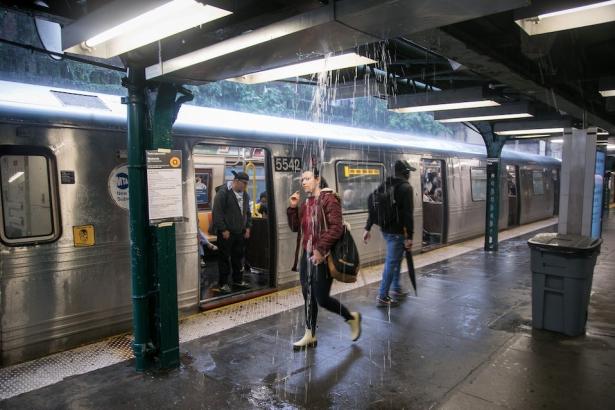New Yorkers trying to get on the subway today faced water streaming out of station walls and ceilings, water up to their hips, and flooded, electrified tracks. The Metropolitan Transit Authority urged riders not to take the train as parents figure out how to get their children home from schools facing similarly dire conditions. New York City Mayor Eric Adams was nowhere to be seen Friday morning, as the possibly one-in-100-year storm struck. Adams’ office defended his radio silence by saying it had put out a press release just after 11 p.m. last night; Adams eventually gave a virtual press briefing around noon, 40 minutes after it was scheduled to begin. (Adams spent the night before the floods at a fundraiser where attendees were encouraged to give more than $2,000.)
As climate change turns flooding into a more regular, deadly problem for the five boroughs, Adams has seemed more concerned during the first months of his administration about inundating the subway with cops, whose main purpose seems to be the implicit threat of physical violence. There are 2,500 NYPD officers deployed in the transit system and an additional 1,000 dispatched there daily. That’s in addition to around 1,100 MTA cops and NYPD officers helping to spend down city resources with excessive overtime. In Times Square, they’ll now be joined by a 400 pound robot cop named K5, leased out from private surveillance company Knighscope for $9 an hour. For reference, as Hell Gate pointed out, just 1,200 officers patrolled the system in 1991, when there were nearly three times as many murders underground and about nine times as many felonies.
On a typical day in New York, packs of cops will stand around on subway platforms chatting or looking at their phones, or hanging around in groups writing expensive tickets for turnstile-jumpers looking to evade the newly increased subway fare. This spring, the city agreed to a nearly 30 percent retroactive pay increase for NYPD officers that will cost $5.5 billion through 2027. Meanwhile, rats scurry by and some mysterious black sludge oozes out of the walls—maybe from the same holes that floodwaters shot out of today. (About half of the entire subway system, one of the most extensive in the world, was suspended during the flooding, officials said.)
The MTA itself, it’s worth noting, is controlled by the state of New York, not the city. Former Governor Andrew Cuomo famously starved it of cash while funneling money toward the highway system (and even on unrelated projects like bailing out the state’s ski resorts, suffering from snow-sparse winters thanks to climate change). Rather than perform routine maintenance on the whole system, Cuomo prioritized flashy projects like building up the Second Avenue subway, which catered to wealthier Upper East Side residents. Under Kathy Hochul, the MTA is still underfunded by millions of dollars each year.
The upshot is that New York City—America’s biggest and arguably most social democratic city—is manifestly unprepared for what climate change has in store for it. The problems it faces from rising temperatures aren’t so unique, but it should theoretically be easier to deal with those problems in a place where Democrats who talk constantly about their commitment to “climate action,” or some such, control just about every relevant elected office. Not so!
New York’s governor and Democratic supermajority can’t seem to agree on taxing the rich a little bit more to help deal with climate change. In 2021, when Hurricane Ida hit the city and the streets flooded like they did on Friday, 16 people, inordinately low-income and immigrant New Yorkers, died from drowning in their basement apartments—yet the powers that be can’t even pass rules that would stop people from dying when their illegally converted basement units flood. It took years of organizing just to pass a bill allowing the state’s public power authority to build renewables. Adams is actively trying to let landlords off the hook for reducing building emissions. All the while, he’s turned the increase of migration into the city into a Trumpian spectacle, blaming the 5 percent cut he wants to impose on city agencies on people who are, in some cases, fleeing the effects of climate change.
Adams’s priorities don’t seem all that different from those of the national GOP, which is now poised to trigger a painful government shutdown over immigration. While Adams is likely to demand some modest cuts from the NYPD, House Republicans are now demanding Congress slash domestic programs by 30 percent, exempting the Department of Homeland Security, the Department of Defense, and the Veterans Administration. Another proposal would nix international disaster aid. Eric Adams’s New York City, that is, may well start looking a lot like the rest of the United States as temperatures rise: increasingly armed, underwater, and hostile to newcomers.
Short of voting out the politicians responsible for that miserable state of affairs, it may be worth considering a short-term solution. If hordes of cops are going to keep polluting New York’s flood-prone subways, the least they could do is grab a bucket and be helpful for once.
Kate Aronoff is a staff writer at The New Republic.


Spread the word